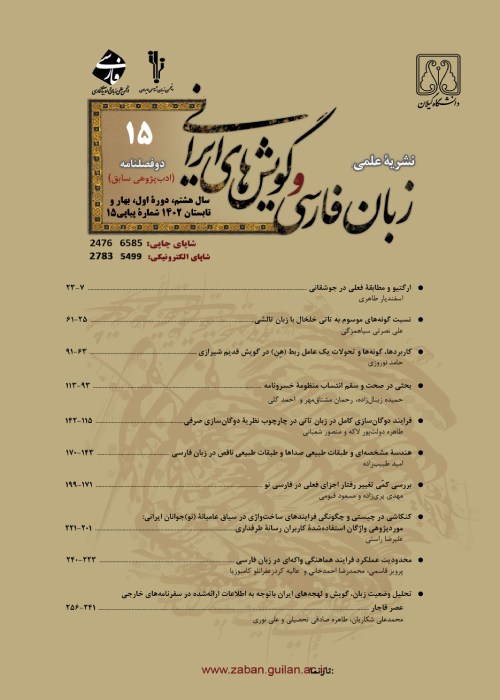Sociolinguistic Analysis of Lullabies in Qa`ini Dielect
Author(s):
Article Type:
Research/Original Article (دارای رتبه معتبر)
Abstract:
Introduction
Oral literature including poetry, songs, lullabies, stories, anecdotes, proverbs and the like is being transferred from generation to generation in an unlettered way. The scholar's lack of interest in folk literature, particularly lullabies, has marginalized this kind of literary art as it is feared today that such works are gradually being forgotten and erased from their speaker`s memory. Therefore, it is of paramount importance to recording and analyzing this part of oral culture which leads to accurately understanding the culture of the people in terms of its various subcultures. Given the location of the city of Qa'in and due to its national and religious prejudices and also the love affairs and deprivations, it is observed that the women of Qa`in console themselves with these folk lullabies.
Theoretical framework
The present research is carried out within the framework of the analytical-qualitative method. Research variables (gender, religious-cultural themes, women's social status, and climatic conditions) are of a descriptive scale and demographic questions (age, level of education, occupation of respondents, and the number of children (daughters and sons)) are numerical variables.
Methodology
Due to the fact that all the women inhabitant in the city of Qa`in have been selected as the research community and since providing a complete list ofpopulation was not accessible, the methods of “non-probable judgment” and “available sampling” have been used. The sample size was 50 determined through the following formula: n = (e: Estimation accuracy or maximum error limit is considered to be 0.15 in this study). Data gathering was carried out through fieldwork using both a researcher-made questionnaire and a personal interview by the researcher. Most of the interviewees encompassed middle-aged and elderly women from both the township and the surrounding villages. The result of one-year research effort in collecting lullabies compiled 692 bits analyzed as the research data. To analyze the data, the collected lullabies were coded, categorized in the same sense, and then all the implied concepts were noted. Possessing the extracted concepts, the researcher returned to the field of research in order to collect other lullabies as far as there remained no new concept of lullabies. Subsequently, concepts which categorized a common theme in a category were categorized and analyzed eventually.
Results and discussion
The quantitative and content analysis of the extant lullabies of Qa`in showed that the Qa`ini mothers have far transmitted their ideas, thoughts and religious beliefs to their children in the form of lullabies along with reflecting the economic and cultural situation of the region and also their own pains. We argued that the contents of the lullabies portray the beauty of nature, the personality traits, the family and social problems of women and the mother's wishes for their children. In addition, we demonstrated that the mothers' age and their social status and education are also effective in choosing the lullabies they sing for their daughters or sons. The results showed that the most frequent lullabies clearly manifest the following subjects: 1) the social status of women 2) the religious themes 3) the cultural and climatic conditions and 4) the gender.The descriptive results of gender variable represented that the relationship between gender and age is a direct relationship, while inverse for education, job and the number of children. Furthermore, there was a direct relationship between age and religious themes in lullabies and also between the employment of women and religious themes. As part of the analysis, it was demonstrated that there was no relationship between education and religious themes in lullabies and between the number of children and religious themes.It was also exhibited that there was direct relationship between age and social status of women in lullabies and also between education and social status of women, while there was inverse relationship between the women's occupation and the number of children with social status of women.
Conclusions & Suggestions
The lullabies identified in the study depicted that there was a direct relationship among age, and the climatic and cultural conditions and also between the employment of women and the number of children with climatic and cultural conditions. Interestingly, our project showed that there was no relationship among education and climatic and cultural conditions in lullabies. Moreover, the results of Friedman test represented that there is a significant difference between the mean of effective variables on the content of lullabies whilst the highest priority was given to gender, religious themes, women's social status, and cultural and climatic conditions.Keywords:
Language:
Persian
Published:
Journal of Persian language and Iranian dialects, Volume:3 Issue: 2, 2019
Pages:
127 to 148
magiran.com/p2008723
دانلود و مطالعه متن این مقاله با یکی از روشهای زیر امکان پذیر است:
اشتراک شخصی
با عضویت و پرداخت آنلاین حق اشتراک یکساله به مبلغ 1,390,000ريال میتوانید 70 عنوان مطلب دانلود کنید!
اشتراک سازمانی
به کتابخانه دانشگاه یا محل کار خود پیشنهاد کنید تا اشتراک سازمانی این پایگاه را برای دسترسی نامحدود همه کاربران به متن مطالب تهیه نمایند!
توجه!
- حق عضویت دریافتی صرف حمایت از نشریات عضو و نگهداری، تکمیل و توسعه مگیران میشود.
- پرداخت حق اشتراک و دانلود مقالات اجازه بازنشر آن در سایر رسانههای چاپی و دیجیتال را به کاربر نمیدهد.
دسترسی سراسری کاربران دانشگاه پیام نور!
اعضای هیئت علمی و دانشجویان دانشگاه پیام نور در سراسر کشور، در صورت ثبت نام با ایمیل دانشگاهی، تا پایان فروردین ماه 1403 به مقالات سایت دسترسی خواهند داشت!
In order to view content subscription is required
Personal subscription
Subscribe magiran.com for 70 € euros via PayPal and download 70 articles during a year.
Organization subscription
Please contact us to subscribe your university or library for unlimited access!


